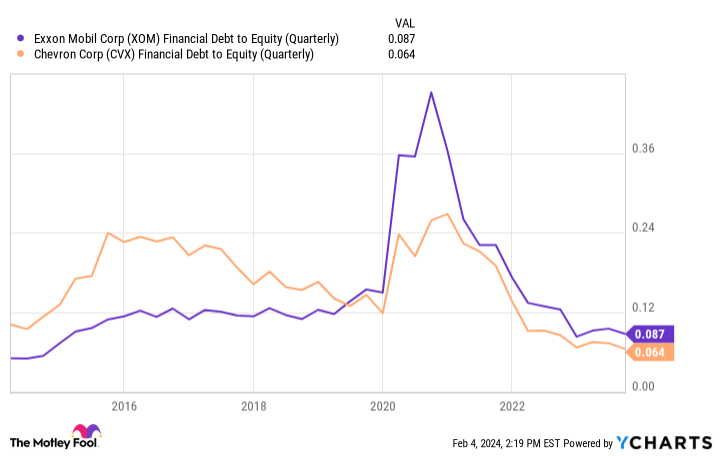The United States is vast and full of natural resources. The Permian Basin is America’s crown jewel for the energy industry, spaning over 86,000 square miles of land along western Texas and parts of New Mexico. The oil and gas-rich region helped drive record production for the U.S. in 2023. Energy giants ExxonMobil (NYSE: XOM) and Chevron (NYSE: CVX), with extensive footprints in the region, play significant roles.
Commodity prices have fallen, pressuring each company’s share price. But after looking at each company’s fundamentals, this could be a dip you want to buy.
Here is what makes these two energy titans screaming buys this month.
Lower oil prices haven’t killed profits
ExxonMobil and Chevron are integrated energy companies that deal in various aspects of the oil & gas industry. That includes exploring and extracting resources from the ground, refining them into different products and chemicals, and selling them. So while neither company entirely relies on commodity prices, something a dedicated exploration company would be vulnerable to, falling prices can still hurt.
The market price for WTI Crude Oil has fallen nearly 40% from its multi-year peak of $114 per barrel to just over $70 today. ExxonMobil and Chevron have fallen between 15% and 20% from their highs.
However, business is still going very well for both companies. Both recently announced Q4 earnings to punctuate 2023, and while profits weren’t at all-time highs due to lower commodity prices, cash from operations (CFO), free cash flow (FCF), and return on capital employed (ROCE) were all stellar compared to their long-term averages:
|
Company |
CFO (10-year ave) |
2023 CFO |
FCF (10-year ave) |
2023 FCF |
ROCE (10-year ave) |
2023 ROCE |
|---|---|---|---|---|---|---|
|
ExxonMobil |
$37.0B |
$55.4B |
$16.7B |
$36.1B |
9.2% |
15% |
|
Chevron |
$25.7B |
$35.6B |
$8.6B |
$19.8B |
6.8% |
11.9% |
The author made the chart using data from Ycharts and company filings.
Each of these metrics means something different, but collectively, profitability is great. Both companies are leaning heavily into the Permian Basin for future growth. ExxonMobil is targeting 650K barrels per day in 2024 to ramp to 1 million barrels per day by 2027. ExxonMobil also has incoming production from its pending $59.5 billion purchase of Pioneer Natural Resources.
Meanwhile, Chevron is guiding for a 10 percent output growth in 2024 and striving to hit 1 million barrels daily in 2025. That builds on top of an all-time production record across the company in 2023. Oil and gas is generally an industry that goes through repeated boom and bust cycles, but as you’ll see below, the past few years have strengthened both ExxonMobil and Chevron’s financials.
Prepared for eventual adversity
High production volumes at profitable margins have created enough cash for each business to fortify its balance sheet after the pandemic, a rocky stretch for much of the past decade. Today, each company boasts a debt-to-equity ratio at its lowest level in years.
ExxonMobil is spending nearly $60 billion in Pioneer, and Chevron has its own pending blockbuster deal to acquire Hess for $53 billion. I like that each company is funding the acquisitions with stock, making each larger without threatening their balance sheets.
Technically, that will dilute shareholders by increasing the number of shares. However, both companies are poised to reign in their share counts with massive share repurchases.
Showering shareholders in cash
As primarily oil and gas companies, ExxonMobil and Chevron will have lumpy, inconsistent growth over the years. Despite the challenges, each company excels at sharing its profits with investors. Both are renowned dividend stocks. ExxonMobil has increased its dividend for 41 consecutive years versus Chevron’s 36-year streak.
Additionally, each company plans to spend tens of billions of dollars to repurchase shares over the coming years. ExxonMobil plans to increase its annual spending on repurchases to $20 billion through 2025 once it closes its Pioneer acquisition. Chevron began a $75 billion repurchase program last April and still has a lot left.
The great thing is that each company could steadily retire the shares issued to acquire Pioneer and Hess, leaving shareholders eventually sitting pretty.
Ultimately, ExxonMobil and Chevron are fantastic businesses, and deciding between them is difficult. Long-term investors who love dividends can confidently buy either (or both) today and sock them away in a diversified portfolio, letting those dividends compound for the foreseeable future.
Should you invest $1,000 in ExxonMobil right now?
Before you buy stock in ExxonMobil, consider this:
The Motley Fool Stock Advisor analyst team just identified what they believe are the 10 best stocks for investors to buy now… and ExxonMobil wasn’t one of them. The 10 stocks that made the cut could produce monster returns in the coming years.
Stock Advisor provides investors with an easy-to-follow blueprint for success, including guidance on building a portfolio, regular updates from analysts, and two new stock picks each month. The Stock Advisor service has more than tripled the return of S&P 500 since 2002*.
*Stock Advisor returns as of February 5, 2024
Justin Pope has no position in any of the stocks mentioned. The Motley Fool has positions in and recommends Chevron. The Motley Fool recommends Pioneer Natural Resources. The Motley Fool has a disclosure policy.
2 Energy Stocks to Buy Hand Over Fist in February was originally published by The Motley Fool
Signup bonus from





